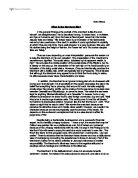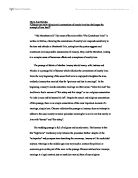Despite being a fashionable businessman and a successful financial expert, he is a terribly unhappy husband, “I have a , the worste that may be.” Critics have painted him as a disillusioned man full of hatred and contempt because of his unhappy relationship with his wife, he says in the Prologue to his tale that if his wife were to marry the devil she would overmatch even him, “For thogh the to hire ycoupled were, She sholde hym , I dar wel swere.” There is evidence that the Merchant hates women and has a disillusioned view of marriage by connecting his experiences to those of January. Part of the Merchant’s hatred for his wife is reflected in January’s blindness to marital responsibility. The Merchant’s blindness leads to the negative attitudes he develops about marriage and contributes to his bitterness.
The Merchant, in his disillusionment, does not advocate romantic sentiment. Instead, he makes it his sole purpose to reduce it, and plans to do so by telling a tale that will portray all wives as deceitful. In turn, any husbands who may be listening will become jealous, and if the Merchant is successful, they will also reject romantic sentiment as he does. It is evident from his tale that the Merchant observed the courtly love code with disdain and that courtly love was simply a mask for lust.
The Merchant becomes a misogynist because of his own emotional blindness, and eventually translates his hatred of women into a self-hatred. It is through January, who acts as an envoy for the Merchant, that it is possible to arrive at this conclusion. Support for the fact that the Merchant holds misogynistic views comes from his description of wives as a gift, numerous times throughout the tale the Merchant refers to wives whether it be his own or May in economic terms: “A wyf is Goddes yifte verraily; Alle othere manere yiftes hardily, As londes, rentes, pasture, or commune, Or moebles -- alle been yiftes of Fortune.”
January serves as a vehicle for the Merchant, whose attitudes, opinions, and perceptions of women classify him undoubtedly as a motley-clad misogynist, for example, when she said that woman were created for mans help” That womman is for mannes helpe ywroght.” Characteristically, he is a fool. January is developed as a vehicle through the connection of teller to tale, textual implications of misogyny, and the limited sight (faulty or deliberate) experienced by key characters.
The Merchant’s misogyny is a product of his marital disillusionment. His misery and resulting hatred could be likened to purchasing a faulty product, or falling victim to false advertisement. One could assume, in a manner of speaking, that he bought more than he bargained for when he entered into marriage. The Merchant has a "special view of the male-female relationship and to the theme of ‘sight’- of the way in which men ‘see’ what their desires condition them to ‘see’- which is a recurrent theme in the general plan."
The fact that the Merchant hates women can be textually supported. Near the very beginning of his tale the Merchant presents us with four exempla of ‘good wives’ from the Bible, “Lo, how that Jacob, as thise clerkes rede, By good of his mooder Rebekke, Boond the kydes skyn aboute his nekke, For which his fadres he wan. “ However, there is an indication of duplicity as each of these wives deceived their husbands in someway. Rebecca (Genesis xxvi) deceived her blind husband by substituting Jacob for Esau and gaining for thw rong son his fatehr’s blessing. Judith saved her people by deciveing and salying Holofernes (Judith xi-xiii) while Abigial (Samuel xxv) saved her husband later to make a marriage-contract with David. The Merchant attempts to justify his misogyny by quoting from scholars, with whom he holds in great contempt, ”Lo, how that Jacob, as thise clerkes rede.” This also reveals the Merchants disdain for the clergy, as these biblical references would have been promoted by the church.
Whether or not January represents him can still be questioned. However, "Chaucer creates an original aesthetic vehicle...to express the cynicism of the Merchant-narrator, whose consciousness of the difference between words and reality would perhaps be all the keener for a man who, while in debt, was sownynge alwey th’encrees of his wynnyng.” It makes sense that the Merchant would fall victim to Chaucerian irony, because as a merchant, he should know well the difference between an object’s appearance and its actual worth.
January and May’s marriage is an institution; she is his property. January will never be able to see May’s adultery because he has never been able to perceive her as anything other than his possession. This perception of a wife as property for the owner’s pleasure directly links the Merchant to January. The Merchant’s jealousy leads him to taint the views of others by providing a one-sided argument that women are all shrews, “She is a shrewe at al.”
May does not necessarily represent the Merchant’s wife, but she does represent his hatred of her and for adulterous women. Early in the tale, the Merchant quotes Theofrastus’ Golden Book on Marriage, a direct attack on matrimony:
"Ne take no wyf," quod he, "for housbondrye,
As for to spare in houshold thy dispence.
A trewe servant dooth moore diligence
Thy good to kepe than thyn owene wyf,
For she wol clayme half part al hir lyf"
By reading a book that overtly attacks the sacrament of marriage, the Merchant identifies himself with those who embrace misogynistic ideas and promote them. The Merchant puts forth the view that happiness in marriage can only be achieved by self-imposed blindness. When old January’s sight is restored, he allows himself to be blinded to the true facts and lets himself believe that his wife is faithful to him.
The Merchant’s feelings towards wives are expressed further when May climbs the tree to greet Damian. May is very manipulative; first she convinces January to help her climb the tree, then she persuades January to believe that she did it all for him. The Merchant’s bitterness is evident as May promises that she was only with Damian so that January would regain his eyesight, “Up peril of my soule, I shal nat lyen, As me was taught, to heele with youre eyen, Was no thyng bet, to make yow to see, Than strugle with a man upon a tree. God woot, I dide it in ful good entente. “ Of course, the young, ‘faithful’ wife only had her husband in mind while she was enjoying a handsome man.
Also, the Merchant is characteristically concerned with property, and how the taking of a wife will diminish it: "The Merchant’s furious indignation at his wife only exacerbates his desire for property. Because his private property has betrayed him -one gathers that his wife was something more than wax- he desires more property all the more intensely, property which, because he owns it, will reinforce his sense of self."
The Merchant holds very strong views on the aristocracy and the court, which is comprehensible as he is a bourgeois. The Merchant reveals these views throughout his tale, for example, when describing the courtmans he creates a sycophantically character who is the ultimate courtier agreeing with everything rather than acting as an advisor, “I holde youre owne conseil is the beste. For, brother myn, of me taak this motif, I have been a court-man al my lyf, And God it woot, though I unworthy be.”
To conclude, the Merchant is a misogynist, he observes the code of courtly love with disdain and holds cynical views about the clergy and the aristocracy. He attempts to support his views by providing exempla, which are more often than not subverted thereby altering their original meaning or inclination. Overall the Merchant takes a very cynical approach to the many issues raised by his tale, revealing a great deal about his character even in the most through-away lines, a vast amount can be learnt.
Bibliography
http://www.luminarium.org/medlit/tolliver.htm
Bowden, Muriel. A Commentary on the General Prologue to The Canterbury Tales. New York: Macmillan,1948.







